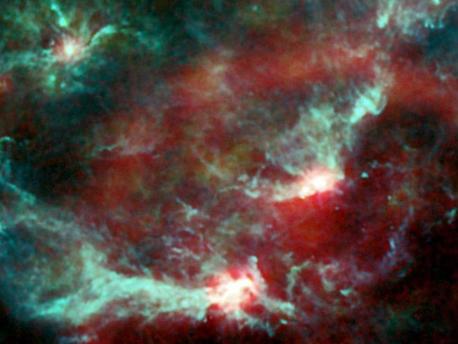The big hunter in the sky
Planck Sees a Cold and Stormy Orion
 © ESA/LFI & HFI Consortia |
A low activity, star-formation region in the constellation Perseus, as seen by Planck. This long-wavelength image covers a square region of 13 by 13 degrees (which is equivalent 26 by 26 full moons). It is a three-color combination constructed from three of Planck's nine frequency channels: 30, 353 and 857 gigahertz.
It shows one such region in our Milky Way, where stars are actively bursting to life. The much-photographed Orion nebula is the bright spot to the lower center. The bright spot to the right of center is around the Horsehead Nebula, so called because at high magnifications a pillar of dust resembles a horse's head. The whole view covers a square patch of sky equivalent to 26 by 26 moons.
"Because Planck is mapping the whole sky, we can capture mosaics of huge regions of the Milky Way," said Charles Lawrence, the NASA project scientist for Planck at NASA's Jet Propulsion Laboratory in Pasadena, Calif. "We are seeing the coldest material in star-forming regions, where stars are at the very earliest stages of formation."
The giant red arc of Barnard's Loop is thought to be the blast wave from a star that blew up inside the region about two million years ago. The bubble it created is now about 300 light-years across.
The picture shows light resulting from two different types of radiation. At the lowest frequencies, Planck primarily maps emission from ionized gas heated by newly formed hot stars. At higher frequencies, Planck maps the meager heat emitted by extremely cold dust. This can reveal the coldest cores in the clouds, which are approaching the final stages of collapse, before they are reborn as full-fledged stars.
Source: NASA
The big hunter in the sky
Planck Sees a Cold and Stormy Orion
 © ESA/LFI & HFI Consortia |
A low activity, star-formation region in the constellation Perseus, as seen by Planck. This long-wavelength image covers a square region of 13 by 13 degrees (which is equivalent 26 by 26 full moons). It is a three-color combination constructed from three of Planck's nine frequency channels: 30, 353 and 857 gigahertz.
It shows one such region in our Milky Way, where stars are actively bursting to life. The much-photographed Orion nebula is the bright spot to the lower center. The bright spot to the right of center is around the Horsehead Nebula, so called because at high magnifications a pillar of dust resembles a horse's head. The whole view covers a square patch of sky equivalent to 26 by 26 moons.
"Because Planck is mapping the whole sky, we can capture mosaics of huge regions of the Milky Way," said Charles Lawrence, the NASA project scientist for Planck at NASA's Jet Propulsion Laboratory in Pasadena, Calif. "We are seeing the coldest material in star-forming regions, where stars are at the very earliest stages of formation."
The giant red arc of Barnard's Loop is thought to be the blast wave from a star that blew up inside the region about two million years ago. The bubble it created is now about 300 light-years across.
The picture shows light resulting from two different types of radiation. At the lowest frequencies, Planck primarily maps emission from ionized gas heated by newly formed hot stars. At higher frequencies, Planck maps the meager heat emitted by extremely cold dust. This can reveal the coldest cores in the clouds, which are approaching the final stages of collapse, before they are reborn as full-fledged stars.
Source: NASA





